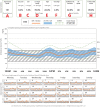Monitoring of Pediatric Type 1 Diabetes
- PMID: 32256447
- PMCID: PMC7089921
- DOI: 10.3389/fendo.2020.00128
Monitoring of Pediatric Type 1 Diabetes
Abstract
Regular self-monitoring of blood glucose levels, and ketones when indicated, is an essential component of type 1 diabetes (T1D) management. Although fingerstick blood glucose monitoring has been the standard of care for decades, ongoing rapid technological developments have resulted in increasingly widespread use of continuous glucose monitoring (CGM). This article reviews recommendations for self-monitoring of glucose and ketones in pediatric T1D with particular emphasis on CGM and factors that impact the accuracy and real-world use of this technology.
Keywords: blood glucose self monitoring; continuous glucose monitor; diabetes management; ketone; type 1 diabetes (T1D).
Copyright © 2020 Marks and Wolfsdorf.
Figures

Similar articles
-
Monitoring of paediatric type 1 diabetes.Curr Opin Pediatr. 2022 Aug 1;34(4):391-399. doi: 10.1097/MOP.0000000000001136. Curr Opin Pediatr. 2022. PMID: 35836398 Review.
-
Continuous Glucose Monitoring (CGM) or Blood Glucose Monitoring (BGM): Interactions and Implications.J Diabetes Sci Technol. 2018 Jul;12(4):873-879. doi: 10.1177/1932296818768834. Epub 2018 Apr 12. J Diabetes Sci Technol. 2018. PMID: 29648465 Free PMC article.
-
Use of flash glucose-sensing technology (FreeStyle Libre) in youth with type 1 diabetes: AWeSoMe study group real-life observational experience.Acta Diabetol. 2018 Dec;55(12):1303-1310. doi: 10.1007/s00592-018-1218-8. Epub 2018 Aug 31. Acta Diabetol. 2018. PMID: 30171412
-
Is there an optimal strategy for real-time continuous glucose monitoring in pediatrics? A 12-month French multi-center, prospective, controlled randomized trial (Start-In!).Pediatr Diabetes. 2019 May;20(3):304-313. doi: 10.1111/pedi.12820. Epub 2019 Feb 6. Pediatr Diabetes. 2019. PMID: 30663187 Clinical Trial.
-
Continuous glucose monitoring: evidence and consensus statement for clinical use.J Diabetes Sci Technol. 2013 Mar 1;7(2):500-19. doi: 10.1177/193229681300700227. J Diabetes Sci Technol. 2013. PMID: 23567009 Free PMC article. Review.
Cited by
-
ROUTE-T1D: A behavioral intervention to promote optimal continuous glucose monitor use among racially minoritized youth with type 1 diabetes: Design and development.Contemp Clin Trials. 2024 May;140:107493. doi: 10.1016/j.cct.2024.107493. Epub 2024 Mar 7. Contemp Clin Trials. 2024. PMID: 38460913 Free PMC article. Clinical Trial.
-
Accuracy of an Off-Label Transmitter and Data Manager Paired With an Intermittent Scanned Continuous Glucose Monitor in Adults With Type 1 Diabetes.J Diabetes Sci Technol. 2024 May;18(3):701-708. doi: 10.1177/19322968221133405. Epub 2022 Oct 25. J Diabetes Sci Technol. 2024. PMID: 36281579 Free PMC article.
-
Disturbed Eating Behaviors in Youth with Type 1 Diabetes: An Exploratory Study about Challenges in Diagnosis.Diagnostics (Basel). 2020 Dec 3;10(12):1044. doi: 10.3390/diagnostics10121044. Diagnostics (Basel). 2020. PMID: 33287458 Free PMC article.
-
Telemedicine for Managing Type 1 Diabetes in Children and Adolescents Before and After the COVID-19 Pandemic.J Clin Med. 2024 Dec 3;13(23):7359. doi: 10.3390/jcm13237359. J Clin Med. 2024. PMID: 39685817 Free PMC article. Review.
-
Advances, Challenges, and Cost Associated with Continuous Glucose Monitor Use in Adolescents and Young Adults with Type 1 Diabetes.Curr Diab Rep. 2021 May 15;21(7):22. doi: 10.1007/s11892-021-01389-1. Curr Diab Rep. 2021. PMID: 33991264 Free PMC article. Review.
References
-
- Miller KM, Beck RW, Bergenstal RM, Goland RS, Haller MJ, McGill JB, et al. Evidence of a strong association between frequency of self-monitoringof blood glucose and hemoglobin A1c levels in T1D exchange clinic registry participants. Diabetes Care. (2013) 36:2009–14. 10.2337/dc12-1770 - DOI - PMC - PubMed
Publication types
MeSH terms
Substances
LinkOut - more resources
Full Text Sources
Medical

